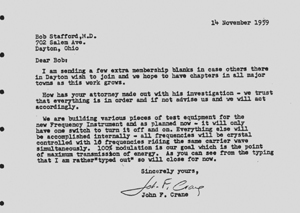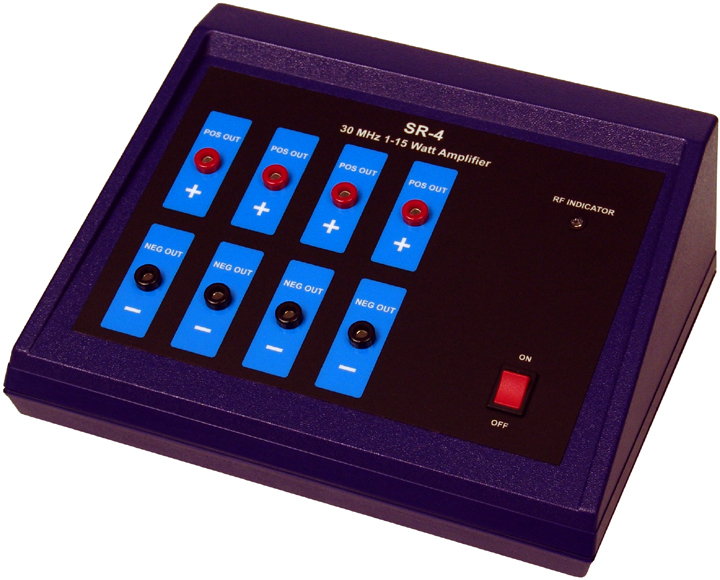Multi-Signaling or Running Multiple frequencies
Some people incorrectly claim that running multiple frequencies simultaneously is not as beneficial as running one at a time. This thinking is not correct. The reason we build instruments with the capability to run 2 to 8 frequencies simultaneously is due to the fact that back in the 1930s/1950s they also built original plasma tube instruments with this capability. If using this method did not work they never would have used it. Here is a statement which is taken from a 1950’s letter which confirms this fact. The last paragraph states this. Quote:
“We are building various pieces of test equipment for the new Frequency Instrument and as planned now - it will only have one switch to turn it off and on. Everything else will be accomplished internally - all frequencies will be crystal controlled with 10 frequencies riding the same carrier wave simultaneously. 100% modulation is our goal which is the point of maximum transmission of energy."
To read the document click on the photo.
 |
This quote clearly shows that they were building instruments that could run 10 frequencies simultaneously back in the late 1950s. The 1936 instrument was built to produce 2 to over 50 harmonic sideband frequencies simultaneously. Because of these facts we knew there would be no problem using this same method as long as we had sufficient bandwidth and used the same power output they did, or greater. Because of these facts, anyone can see that running multiple frequencies simultaneously is not a new concept, and we did not invent it. The original instruments could run 10 audio frequencies simultaneously, and we only run up to 8 simultaneously. People have asked us why we limited the GB-4000 to 8 frequencies instead of 10. It is the duty cycle of a square wave that is the reason we only run up to 8 frequencies simultaneously. A little math will easily explain and show the reason why.
The original instruments had a fixed 50% square wave duty cycle, but we have a variable 10% to 100% square wave duty cycle. Because 10 frequencies with a 50% square wave duty cycle are only equal to 5 frequencies with a 100% square wave duty cycle it is easy to understand that 8 frequencies with a 100% square wave duty cycle are equal to 16 frequencies with a 50% fixed duty cycle. When you run square wave frequencies you need to have some off-time for the frequencies to work correctly. Therefore you never want to run multiple frequencies with more than a 90% duty cycle, and this is the reason we limited the GB-4000 to a maximum 8 frequencies simultaneously. The real question that should be asked is, why did they do this? The answer is a very simple one, time is money.
The benefit of running frequencies simultaneously is an enormous time-saving feature. The average time a frequency is run for is 3 to 5 minutes. If you run 8 frequencies one at a time it will take 40 minutes to run all 8, but if you run all 8 simultaneously then it would only take 5 minutes to run all of them. Many programs have 20 or more frequencies in them which could take you hours to run them. This is why an instrument that can run multiple frequencies simultaneously is a great time-saving advantage to have. Only one other company uses this method but they can only run 3 frequencies simultaneously and you have to purchase 2 additional separate frequency generators at $1200 each. If you purchase one GB-4000 you are getting 8 frequency generators for the price of one.
The GB-4000 with either the SR-4 or the M.O.P.A. can output up to 8 frequencies simultaneously up to 40,000 Hertz and 2 frequencies up to 20MHz (20 million Hertz). With this frequency range, it has the ability to generate millions of frequencies which can be put into individual channels and run as sequences of individual frequencies or sequences of multiple frequencies. The oscilloscope square wave frequency photo, shown below, is of the GB-4000 waveform running 8 frequencies simultaneously.

We have been selling frequency generators for over 24 years now and building our own for 20 years. All of the instruments that we have built over the many years have had the ability to run individual frequencies or multiple frequencies from 2 to 8 simultaneous. The GB-4000 works with either the SR-4 or M.O.P.A. producing this same time-saving capability.
In order to output up to 8 individual frequencies simultaneously, we use 1 Digital synthesizing processor (or DSP) and 2 Direct digital synthesizers (or DDS) for creating arbitrary waveforms from a single, fixed-frequency reference clock. We also use a fixed crystal oscillator which is set at 3.1 MHz for our RF carrier frequency. The 2 Direct digital synthesizers are used to output up to 2 frequencies simultaneously from 1 Hertz to 20 million Hertz. The Digital synthesizing processor is capable of outputting 1 to 8 individual frequencies simultaneously up to 40,000 Hertz. These frequencies are then summed together so all of the frequencies are at the same power level. They are then converted to analog using a Digital-to-analog converter (DAC) and output from the GB-4000 to either the SR-4 one to 15-watt amplifier or M.O.P.A. amplifier. This makes it possible to run frequencies individually or up to 8 audio frequencies simultaneously to 40,000 Hertz and 2 frequencies from 40,001 Hertz to 20 million Hertz.
Some unknowledgeable people claim and incorrectly believe that running multiple frequencies simultaneously causes the purity of each individual waveform to be lost as well as creating the possibility of canceling out or creating other frequencies. They claim it “would be like an orchestra where every instrument plays a different tune creating an incredible cacophony taking away from the clarity of the signal." The definition of cacophony is “a discordant and meaningless mixture of sounds."
A meaningless mixture of sounds only matters if we are wanting to listen to music, not when we run specific frequencies that are not even heard by the ear. Just because each individual instrument in an orchestra plays a different tune does not mean the other tunes are canceled out. Even though frequencies combined together may seem to lose their individual clarity, all the components of each frequency are still present and it is the power output and high bandwidth capability that makes this possible.
Think of an orchestra playing many different instruments. Though they combine together to make beautiful music, each instrument’s full sound components are still present and nothing is lost, even if you add additional instruments to the orchestra. In order for a frequency to be canceled out, the same frequency must be introduced 180 degrees out of phase. Since the GB-4000 does not output the same frequency 180 degrees out of phase the canceling of a frequency is not possible. The only thing that can really affect running multiple frequencies simultaneously is power and bandwidth and we will discuss this next.
Why Power and Bandwidth is important
when Running Multiple Frequencies
Bandwidth is important because if it is not sufficient then many components of a frequency can be lost. The GB-4000, SR4 and M.O.P.A's bandwidth is 800MHz which means nothing is lost when running up to 8 frequencies simultaneously.
The most often asked question about running multiple frequencies is, does it reduce the power level of the frequencies? Yes, it does, and this is why the same 1930s/1950s power levels of 50 to 75-watts for plasma tube instruments must be used. For the contact method developed in 1957, they used power levels of only 1/10th (0.10) to 1/5th (0.20) of 1-watt for a single frequency. Most people cannot handle more than 1/10th of 1 watt of power. Logically when using the 1957 power level if you used 2 audio frequencies you would want to double that power level (2 X 1/10th = 0.20 of 1-watt) to 0.20% of 1-watt. If you run up to 8 audio frequencies you would want at least 8 times that power level or 0.80 of 1-watt. This is why the GB-4000 has 4.7-watts power output so that it has almost 6 times the power capability needed for running 8 audio frequencies simultaneously at the original 1957 capability.
Using an RF carrier frequency is the only way the power level could be increased. The original 1957 contact instrument did not use an RF carrier frequency so they could only output one audio frequency at a time with only 0.10 (1/10th) to 0.20 (1/5th) of one watt of power. This power level worked very well with only one audio frequency. In order to overcome this limitation, an RF carrier frequency must be used and this is why the GB-4000 uses two separate output circuits.
The "Audio Mode" circuit has no RF carrier frequency and has a maximum of 0.75-watts power output. It is used for frequencies from 1 Hertz to 400,000 Hertz. Frequencies used with this "Audio Mode" circuit can be physically felt from 1 to about 20,000 Hertz.
The "RF Mode" circuit is used for frequencies from 1 Hertz to 20 million Hertz. The 3.1 MHz carrier frequency can also be used with this circuit. Because of the RF carrier, any audio frequencies cannot be felt. Using this method it is possible to use 4.7-watts and make it possible to run up to 8 frequencies simultaneously with almost 6 times the 1957 power level per frequency. If only one frequency is run then this is about 47 times more power output than the 1957 instrument.
Many people want even more power than the GB-4000 power levels per audio frequency. If you want more power then you can purchase the SR-4 1 to15-watt amplifier and you will have 1.87-watts of power for each frequency if you run 8 audio frequencies simultaneously. If you decide to only run 4 audio frequencies simultaneously then you would have 3.75-watts of power for each frequency. And if you only run one frequency you can have up to 15-watts of power for a single audio frequency.
If you want even more power than 15-watts of power then you can purchase the M.O.P.A. gas tube amplifier which is a variable 20 to 190-watts maximum power instrument. With this instrument, you could run up to 8 audio frequencies simultaneously with up to 23.75-watts of power for each audio frequency.
We look at it as going from good to better to best. |

